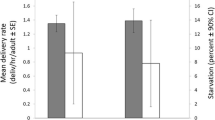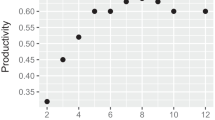Summary
White-fronted bee-eaters (Merops bullockoides) are cooperative breeders in which half of all nesting attempts are assisted by non-breeding adults in addition to the breeding pair. These “helpers” assist in all aspects of nesting and their aid significantly increases fledging success. The social unit in these bee-eaters is an extended family clan in which multiple pairs may breed simultaneously (plural breeding). As a result, helpers often have to choose how to allocate their aid among several potential recipients to whom they are unequally related. Using five years of data from a color-marked and genealogically known population of white-fronted bee-eaters in Kenya, we examined the role of kinship in three helping “decisions”: 1) whether or not to become a helper, 2) whom to help, and 3) how much help to provide.
-
1)
Kinship between potential donor and recipient was a significant predictor of the likelihood of helping. Fully 44% of the individuals that could have become helpers did not do so. Many of these non-helpers were unrelated mates (“in-laws”) that had paired into their partner's clan and had no genetic link to the available recipients. Others were natal clan members with only distant genealogical ties to the breeders. The conditional probability of helping (see text for definition) decreased significantly with decreasing r h(coefficient of relatedness) between the potential helper and nestling recipients. The presumed cost of helping was a second significant predictor of whether or not a bird became a helper. We considered the expending of effort in providing aid and the delaying of personal reproduction to be costs of helping. Potential helpers that had engaged in high effort activities in the few weeks prior to the helping opportunity showed a decreased likelihood of becoming helpers. Similarly, paired birds (which by virtue of having a mating partner had a greater potential of breeding) were less likely to become helpers than were single individuals.
-
2)
Bee-eater helpers preferentially chose to aid their closest genetic relatives. The average relatedness between helpers and the nestlings receiving their aid was 0.33. This degree of kinship was significantly greater than that expected if helpers had selected recipient nests randomly from among those available within their clans. Further evidence of kin discrimination came from analysis of 115 instances in which a helper had two or more nests of differing relatedness simultaneously available as potential recipients. In 108 cases (94%), the helper aided the most closely related one.
-
3)
The magnitude of the helping contribution (as measured by provisioning rate) showed no pattern with relatedness between donor and recipient. These data allow testing of various theoretical models for the allocation of aid among kin. Since bee-eaters helped at only one nest at a time, and selected the nest with the most closely related young available, their behavior conforms to an allor-none case of a diminishing returns model and is inconsistent with alternative models based upon the distribution of aid in proportion to relatedness. We conclude that kinship is a major determinant in the decisions both of whether to become a helper, and of whom to help, in white-fronted bee-eaters.
Similar content being viewed by others
References
Altmann SA (1979) Altruistic behavior: the fallacy of kin deployment. Anim Behav 27:958–959
Barash DP (1977) Sociobiology and behavior. Elsevier, New York
Brown JL (1975) The evolution of behavior. Norton, New York
Brown JL (1978) Avian communal breeding systems. Annu Rev Ecol Syst 9:123–156
Brown JL (1980) Fitness in complex avian social systems. In: Markl H (ed) Evolution of social behavior: hypotheses and empirical tests. Dahlem Konferenzen. Verlag Chemie, Weinheim, pp 115–128
Brown JL (1987) Ecology and evolution of helping and communal breeding in birds. Monograph Beh Ecol. Princeton University Press
Brown JL, Dow DD, Brown ER, Brown SD (1978) Effects of helpers on feeding of nestlings in the grey-crowned babbler (Pomatostomus temporalis). Behav Ecol Sociobiol 4:43–59
Clarke MF (1984) Co-operative breeding by the Australian Bell Miner Manorina melanophrys: a test of kin selection theory. Behav Ecol Sociobiol 14:137–146
Dawkins R (1976) The selfish gene. Oxford University Press, Oxford
Dawkins R (1979) Twelve misunderstandings of kin selection. Z Tierpsychol 47:61–76
Emlen ST (1978) The evolution of cooperative breeding in birds. In: Krebs JR, Davies NB (eds) Behavioral ecology: an evolutionary approach. Blackwell, Oxford, pp 245–281
Emlen ST (1981) Altruism, kinship and reciprocity in the whitefronted bee-eater. In: Alexander RD, Tinkle DW (eds) Natural selection and social behavior. Chiron, New York, pp 217–230
Emlen ST (1984) Cooperative breeding in birds and mammals. In: Krebs JR, Davies NB (eds) Behavioral ecology: an evolutionary approach, 2nd edn. Blackwell, Oxford, pp 305–339
Emlen ST (1988) The white-fronted bee-eater: helping in a colonially nesting species. In: Stacey PB, Koenig WD (eds) Cooperative breeding in birds: Long term studies of avian demography and behavior. Cambridge University Press, Cambridge (in press)
Emlen ST, Wrege PH (1986) Forced copulations and intraspecific parasitism: two costs of social living in the white-fronted bee-eater. Ethology 71:2–29
Hamilton WD (1964) The genetical evolution of social behavior. J Theor Biol 7:1–52
Hegner RE, Emlen ST, Demong NJ (1982) Spatial organization of the white-fronted bee-eater. Nature 298:264–266
Hegner RE, Emlen ST (1987) Territorial organization of the white-fronted bee-eater in Kenya. Ethology 76:189–222
Koenig WD, Mumme RL (1987) Population ecology of the cooperatively breeding Acorn Woodpecker. Princeton University Press. Monogr Popul Biol 24:1–435
Payne RB, Payne LL, Rowley I (1985) Splendid wren Malurus splendens response to cuckoos: an experimental test of social organization in a communal bird. Behavior 94:108–127
Rabenold KN (1985) Cooperation in breeding by nonreproductive wrens: kinship, reciprocity, and demography. Behav Ecol Sociobiol 17:1–17
Reyer HU (1980) Flexible helper structure as an ecological adaptation in the pied kingfisher (Ceryle rudis rudis). Behav Ecol Sociobiol 6:219–227
Reyer HU (1984) Investment and relatedness: a cost/benefit analysis of breeding and helping in the pied kingfisher (Ceryle rudis). Anim Behav 32:1163–1178
Rowley I (1981) The communal way of life in the Splendid Wren, Malurus splendens. Z Tierpsychol 55:228–267
SAS Institute Inc (1985) SAS Users Guide: Statistics, 1985 Edition, Cary, NC: SAS Institute, Inc.
Saunders C (1987) Ecological, social and evolutionary aspects of baboon (Papio cynocephalus) grooming behavior. PhD thesis, Cornell University
Schulman SR, Rubenstein DI (1983) Kinship, need, and the distribution of altruism. Am Nat 121:776–788
Smith AJ, Robertson BI (1978) Social organization of bell miners. Emu 78:169–178
Sokal RR, Rohlf FJ (1981) Biometry, 2nd edn. Freeman, New York
Stallcup JA, Woolfenden GE (1978) Family status and contribution to breeding by Florida scrub jays. Anim Behav 26:1144–1156
Swainson GW (1970) Co-operative rearing in the bell miner. Emu 70:183–188
Weigel RM (1981) The distribution of altruism among kin: a mathematical model. Am Nat 118:191–201
West-Eberhard MJ (1975) The evolution of social behavior by kin selection. Quart Rev Biol 50:1–33
Woolfenden GE, Fitzpatrick JW (1978) The inheritance of territory in group-breeding birds. Biosci 28:104–108
Woolfenden GE, Fitzpatrick JW (1984) The Florida scrub jay: demography of a cooperative breeding bird. Princeton University Press, Princeton, Monogr Popul Biol 20:1–407
Wrege PH, Emlen ST (1987) Biochemical determination of parental uncertainty in white-fronted bee-eaters. Behav Ecol Sociobiol 20:153–160
Author information
Authors and Affiliations
Rights and permissions
About this article
Cite this article
Emlen, S.T., Wrege, P.H. The role of kinship in helping decisions among white-fronted bee-eaters. Behav Ecol Sociobiol 23, 305–315 (1988). https://doi.org/10.1007/BF00300577
Received:
Accepted:
Issue Date:
DOI: https://doi.org/10.1007/BF00300577




